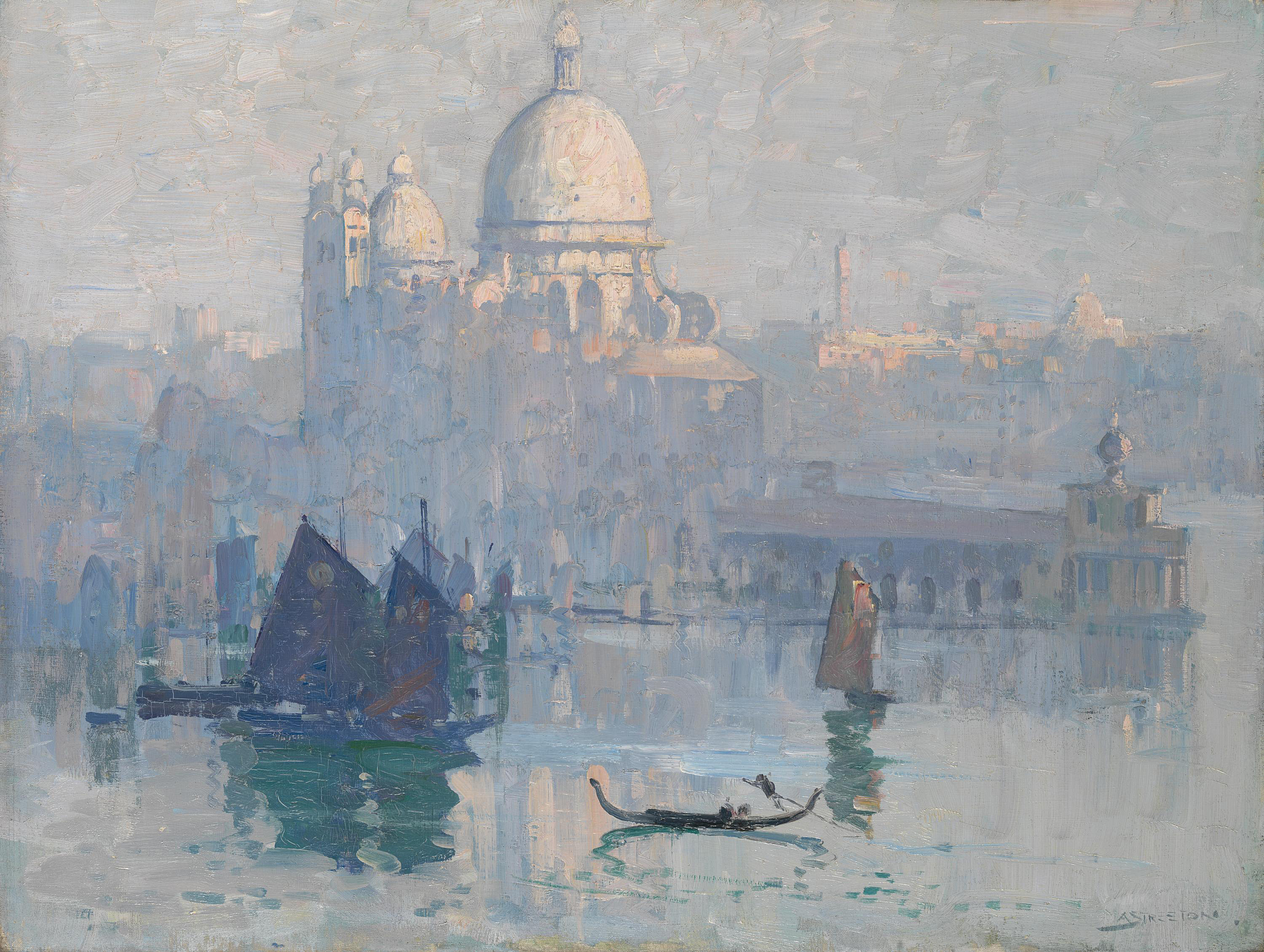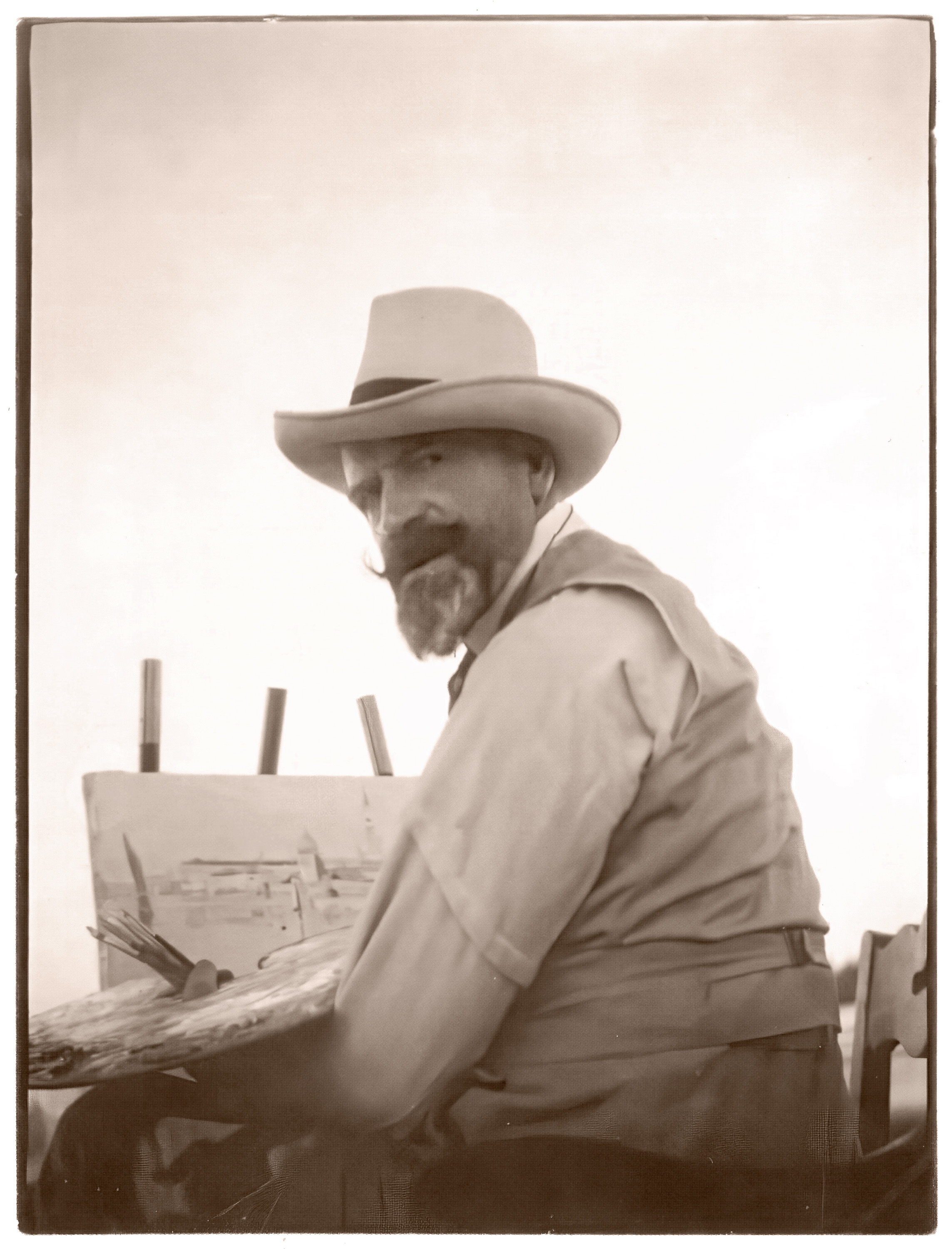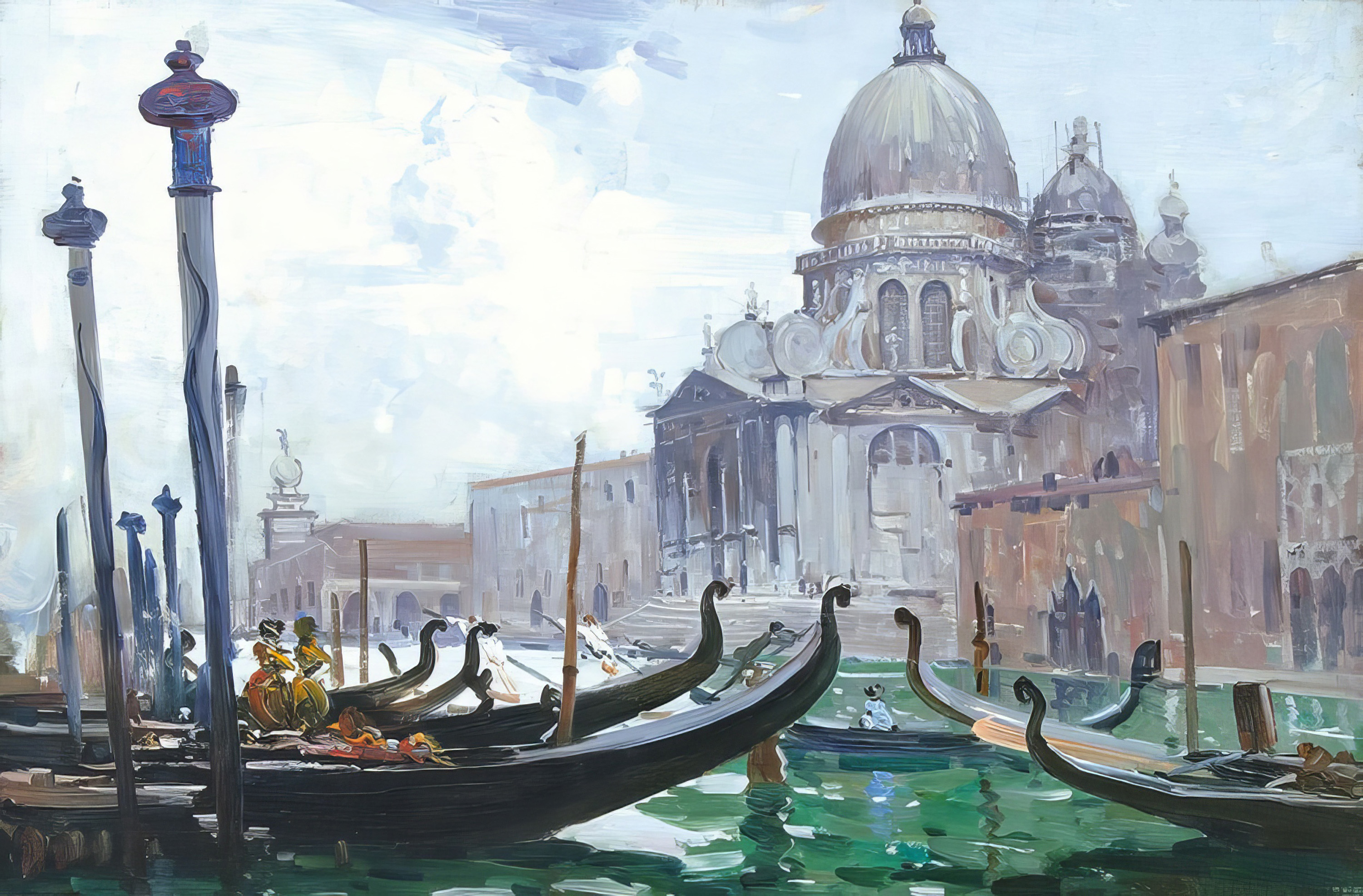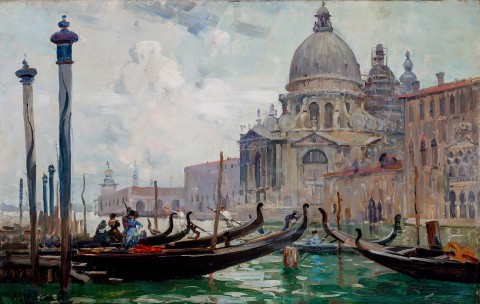LA SALUTE, 1908
ARTHUR STREETON
oil on canvas
53.5 x 84.5 cm
signed lower left: A STREETON
signed and inscribed with artist’s address on stretcher bar: Arthur Streeton/10 Hill Rd/Abbey Road London NW
inscribed with title on stretcher bar verso: (La Salute) 80 Guineas
original Chapman Brothers frame, London
Arthur Baillieu, Melbourne
Amy Shackell (née Baillieu), Melbourne (Arthur Baillieu’s sister)
Sandra Clarke (née Shackell), Devon Park, western Victoria from December 1957
Thence by descent
Private collection, Sydney
Probably Mr Streeton’s Pictures, Victorian Artists’ Society Gallery, Melbourne, opened 5 June 1914, cat. 42 (as ‘Santa Maria della Salute’, 33”x 21”, £52)
Sir Arthur Streeton Exhibition, Adelaide Festival of Arts, John Martin & Co., Adelaide, 6-23 March 1968, cat. 29 (label attached verso)
Santa Maria della Salute (grey),1908, oil on canvas, 51.0 x 76.5 cm, Geelong Art Gallery collection, gift of TS Hawkes in 1914
Santa Maria della Salute (sunny),1908, oil on canvas, 49.5 x 75.2 cm, private collection
We are grateful to Peter Perry, former Director of the Castlemaine Art Gallery and Historical Museum, for his assistance with this catalogue entry.
ArthurSTREETON-SunriseonS-Dd104943 cmyk.jpg

‘…Mr Streeton has caught the opalescence and glitter of the Venetian canals and marble palaces in moments of bright sunshine as few artists have done before him… he succeeds with delighting the eye and filling the heart with pleasure…’1
With their sumptuous colour, sparkling light and dramatic theatrical presence, Arthur Streeton’s paintings of ‘La Serenissima’ remain without doubt among the most highly admired and beautiful of his entire oeuvre. Although not the first Antipodean artist to be captivated by the unique light and romanticism of this fairytale city – Hans Haysen had visited in 1902, inspired by the work of the Venetian old masters which he had previously seen in Paris, and in the spring of 1907, Emanuel Phillips Fox and his artist wife Ethel Carrick had honeymooned in Venice, painting en plein air small ‘travelling’ impressions of the city – Streeton was arguably the most successful. Created during the happiest of circumstances – his honeymoon to Venice in the spring of 1908 – indeed, such works exude a joyfulness, atmospheric truth and mastery of colour and touch evoking the bravura style of his eminent American contemporary, John Singer Sargent, who was also working in Venice around the turn of the century. As Louis McCubbin later reflected in the catalogue accompanying the major Streeton Memorial Exhibition in 1944: ‘…the fading glories of the City of the Adriatic were never more exquisitely rendered. He [Streeton] painted, as if by magic, St Mark’s, the Doge’s Palace, the canals and gondolas, all bathed in the soft golden sunlight of Northern Italy.’2
250126 Arthur Streeton with easel, Venice-(cleaned).jpg

Streeton first met Esther Leonora (Nora) Clench, a Canadian violinist, in London in May 1899 at a soirée hosted by the Goetzes at their home, Grove House, Regents Park. Although immediately taken by her, the two did not begin courting until several years later, eventually marrying on 11 January 1908 and travelling to Venice from April to May of that year for their honeymoon. Working outdoors, often surrounded by crowds of inquisitive onlookers, Streeton painted in oil and watercolour, as well as making a series of sketches in pencil and wash which provided reference for works that he developed later in the studio. Paintings produced during and following this visit – and during a return trip that the couple made later the same year during the poetic months of autumn – depict Piazza San Marco, the Rialto Bridge and numerous other picturesque views featuring the canals and striking architecture of the city. Rich in inspiration, Venetian subjects notably featured in 79 of the 85 paintings he recorded for 19083; as Streeton wrote to a friend at the time, ‘…I worked hard and did some good pieces… What a wonderful place it is.’4
When Streeton subsequently exhibited a selection of his Venetian vedute at the Alpine Club, London in March 1909, they received considerable positive attention in the press. Describing Streeton’s brushwork as ‘swift’ and ‘able’, critics admired the luminosity of his depictions, one writing that ‘they seem… to radiate the light and colour which fills them’5, while the reviewer for The Observer extolled the way in which ‘…the Australian painter has not confined himself to a mere architectural record, but makes us feel that Venice has retained in our days a certain something of the spirit which in the eighteenth century made it the pleasure ground of Europe...’6
250126 Streeton Geelong Gallery-(cleaned).jpg

Upon the unveiling of Streeton’s Venetian paintings in Australia – in the immensely successful exhibitions held at Guild Hall, Melbourne in July 1909 and later, at the Victorian Artists’ Society in June 1914 (which most likely included the present work) – the praise from local audiences was equally effusive. As the critic from The Bulletin noted, ‘Streeton has practically painted everything worth mentioning in the sloppy capital of the Adriatic… he has gathered his information at all hours of the day, even catching the dawn on La Salute and watching the last gondola going to roost. The result is an imposing record of an architecture and atmospheric effects, of quaint bridges and quiet waterways, all demonstrating a magical craftsmanship and a gorgeous sense of colour values.’7 That Streeton’s Venetian paintings were widely acclaimed among his best achievements at the time is attested by the prestigious private and public collections they subsequently entered, from those of Sir Baldwin Spencer; Howard Hinton; Dr D.R. Scheumack; and Sir Edward Hayward of Adelaide’s Carrick Hill, to the National Gallery of Victoria; National Gallery of Australia; Art Gallery of New South Wales; and the University of Melbourne.
A stunning example of Streeton’s talent for capturing the shimmering light and ethereal beauty of this most romantic of Italian cities, La Salute, 1908 bears an equally impeccable, unbroken chain of provenance – originally acquired by Arthur Sydney Bailleu and remaining in different branches of the family over the century since. A keen patron of Streeton, having commissioned several works from the artist8 and owned at least one other of his Venetian paintings – namely, the magnificent The Grand Canal, 1908, sold by Deutscher and Hackett in April 2021 for $3,068,182 (currently the highest price achieved at auction for the artist) – Baillieu was an influential figure who, as the father of the major Australian art patron Sunday Reed, also laid the foundations for the Heide Museum of Modern Art.
250126 Streeton-(cleaned).jpg

Featuring one of Venice’s most iconic ecclesiastical monuments, the magnificent Basilica di Santa Maria della Salute – built in 1682 as a Senatorial vow to the Madonna following the 1630 plague in which a third of Venetian citizens died – the present view was most likely painted by Streeton from diagonally across the Grand Canal, next to the Chiesa di Santa Maria del Giglio. As suggested by Roger Benjamin, the building where Streeton was situated must have been the Venetian Gothic mansion built in the fifteenth century and once the home of Doge Andrea Gritti.9 Upgraded in 1895 as the Grand Hotel (and later in the mid-twentieth century as the majestic Gritti Palace Hotel), the terrace of the hotel in 1908 – as today – opened onto the Campo Santa Maria Zobenigo which had a landing point for the ubiquitous traghetti and gondolas pictured in Streeton’s view here. Streeton often returned to his most loved or successful compositions and thus, unsurprisingly, he produced two other very closely related versions of this view – namely, the almost-identical Santa Maria Della Salute (Grey), 1908 housed in the Geelong Art Gallery and the sun-bathed Santa Maria della Salute (Sunny), 1908 (private collection). Yet, as a contemporary reviewer noted at the time, ‘when he [Streeton]… gives varieties of the same scene, he has some technical effort or charming colour mystery to reveal’10; accordingly, the greater architectural detail and tighter brushwork of the present composition would suggest its execution prior to the other two more highly impressionistic interpretations which, as intimated by their titles, seem to have been intended primarily to depict the edifice at two quite different times (of day and conditions of weather).
Quite assuredly among Streeton’s finest Venetian works, indeed La Salute encapsulates superbly both the artist’s technical skill and sheer delight in rendering the aqueous beauty and opulent splendour of La Serenissima. As the New York art critic, Irwin MacDonald, enthused of Streeton’s Venetian achievements at the time, ‘…he swiftly transferred to canvas what he saw, undisturbed by the golden visions of Turner, and subtle harmonies of Whistler as he was by the merciless architectural details of Canaletto… dashing in his colours with big free brushstrokes, he caught the very spirit of Venice as she is today – with all her opulence of colour, her vividness and gaiety.’11
1. Observer, London, 4 April 1909, cited in Galbally, A., Arthur Streeton, Lansdowne Press, Melbourne, 1979, p. 71
2. McCubbin, L., ‘An Appreciation’, Arthur Streeton Memorial Exhibition, National Gallery of South Australia, Adelaide, 1944, n.p.
3. See Streeton, A., The Arthur Streeton Catalogue, published by Arthur Streeton, Melbourne, 1935, unpaginated
4. Arthur Streeton to Frederick Delmer, 1 July 1908, cited in Galbally, A. and Gray, A. (eds.), Letters from Smike: The Letters of Arthur Streeton 1890 – 1943, Oxford University Press, Melbourne, 1989, p. 113
5. Irwin MacDonald, M., ‘Arthur Streeton: an Australian painter who has solved the problems of art in his own way’, The Craftsman, vol. XVII, no.2, New York, November 1909, p. 163
6. Observer, op. cit.
7. The Bulletin, Sydney, vol. 35, no. 1792, 18 June 1914, pp. 8 – 9
8. See Croll, R.H., Smike to Bulldog: Letters from Arthur Streeton to Tom Roberts, Ure Smith, Sydney, 1946, pp. 90 – 91
9. Benjamin, R., ‘Arthur Streeton’s Venice’, in Tunnicliffe, W. (ed.), Streeton, Art Gallery of New South Wales, 2020, p. 222
10. ‘Mr Streeton’s Pictures’, Punch, Thursday 24 December 1914, p. 35
11. Irwin MacDonald, op. cit.


